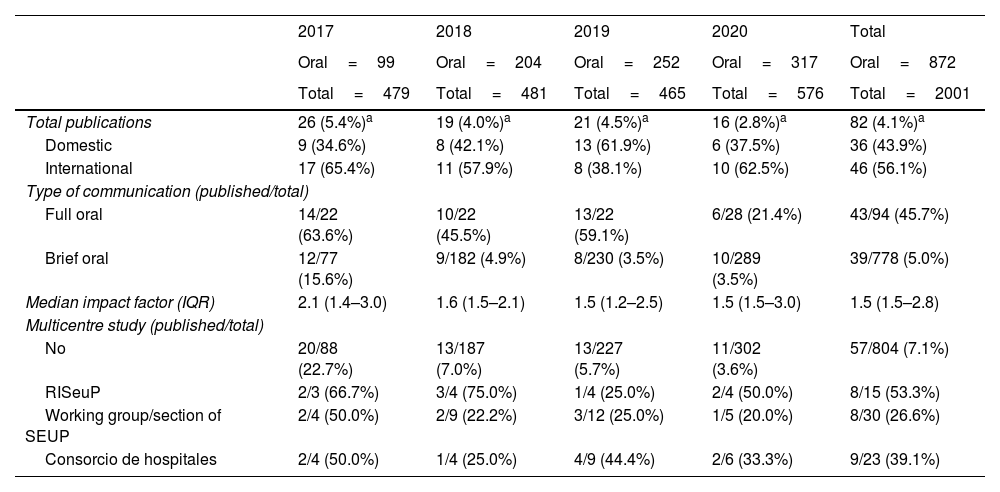In recent years, the number of scientific presentations in the Annual Meeting of the Sociedad Española de Urgencias de Pediatría (SEUP, Spanish Society of Paediatric Emergency Medicine) has been growing gradually. Our aim was to analyse which percentage of the studies presented in the annual meetings of the SEUP in recent years were subsequently published in an indexed journal. To this end, we carried out a search in 3 databases (Medline, Embase y Medes) for the abstracts of the studies presented as oral communications in the annual meetings of the SEUP in the 2017–2020 period, which are available at the website of the SEUP (https://seup.org/), entering as key words the last name of the first and last authors of each communication as well as the name of the hospitals they were affiliated to. Although the study did not involve participation of any patients, we still sought the approval of the competent clinical research ethics committee.
Of the 890 oral communications presented at the last 4 annual meetings, we were able to retrieve information for 872 (98.0%). Of this total, 82 (9.4%) had been published in an indexed journal, 46 (56.1%) in journals outside of Spain. Table 1 presents the characteristics of these publications, overall and by year. Reports of multicentre studies were published more frequently compared to single centre studies (38.8% vs 7.1%; P<.01). Of the 30 hospitals that had made the largest number of communications, 16 (53.3%) did not publish any of the presented studies, while among the remaining hospitals the percentage of published works ranged from 2.5% to 43.5% of the communications, and this percentage only exceeded 30% for 3 hospitals. Fig. 1 shows the percentage of communications in which the study was subsequently published for hospitals with at least 15 communications in the period under study.
Characteristics of published communications, overall and by year.
| 2017 | 2018 | 2019 | 2020 | Total | |
|---|---|---|---|---|---|
| Oral=99 | Oral=204 | Oral=252 | Oral=317 | Oral=872 | |
| Total=479 | Total=481 | Total=465 | Total=576 | Total=2001 | |
| Total publications | 26 (5.4%)a | 19 (4.0%)a | 21 (4.5%)a | 16 (2.8%)a | 82 (4.1%)a |
| Domestic | 9 (34.6%) | 8 (42.1%) | 13 (61.9%) | 6 (37.5%) | 36 (43.9%) |
| International | 17 (65.4%) | 11 (57.9%) | 8 (38.1%) | 10 (62.5%) | 46 (56.1%) |
| Type of communication (published/total) | |||||
| Full oral | 14/22 (63.6%) | 10/22 (45.5%) | 13/22 (59.1%) | 6/28 (21.4%) | 43/94 (45.7%) |
| Brief oral | 12/77 (15.6%) | 9/182 (4.9%) | 8/230 (3.5%) | 10/289 (3.5%) | 39/778 (5.0%) |
| Median impact factor (IQR) | 2.1 (1.4–3.0) | 1.6 (1.5–2.1) | 1.5 (1.2–2.5) | 1.5 (1.5–3.0) | 1.5 (1.5–2.8) |
| Multicentre study (published/total) | |||||
| No | 20/88 (22.7%) | 13/187 (7.0%) | 13/227 (5.7%) | 11/302 (3.6%) | 57/804 (7.1%) |
| RISeuP | 2/3 (66.7%) | 3/4 (75.0%) | 1/4 (25.0%) | 2/4 (50.0%) | 8/15 (53.3%) |
| Working group/section of SEUP | 2/4 (50.0%) | 2/9 (22.2%) | 3/12 (25.0%) | 1/5 (20.0%) | 8/30 (26.6%) |
| Consorcio de hospitales | 2/4 (50.0%) | 1/4 (25.0%) | 4/9 (44.4%) | 2/6 (33.3%) | 9/23 (39.1%) |
IQR: interquartile range; RISeuP: Research Network of the Sociedad Española de Urgencias de Pediatría; SEUP: Sociedad Española de Urgencias de Pediatría.
Despite the limitations, for instance, having searched only the first and last authors of the communications, which could have resulted in missing some publications, or that some of the studies presented in the last annual meeting may still be undergoing the editorial review process in a journal, we believe that the results of our study show that the translation of communication in the annual meeting of the SEUP into publication is lower compared to the figure reported for other specialities.1,2 Multicentre studies are published more frequently, and, in this regard, the SEUP has facilitated this type of research through the development of working groups and its research network (RISEUP).3 On the other hand, we found that the increase in the number of annual communications was mostly due to an increase in brief communications, while the absolute number of publications remained constant. It is worth considering whether an increase in brief communications may not detract from the scientific relevance of the annual meetings. However, such consideration must also take into account the other objectives of a scientific gathering, such as education, awareness or funding for scientific societies.4
In conclusion, the current percentage of the studies presented as communications in the annual meeting of the SEUP that are subsequently published in indexed journals is lower compared to other scientific societies and varies substantially between the hospitals affiliated to the society.
FundingThis research did not receive any external funding.






